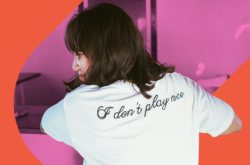Kitty is a producer, songwriter, vocalist, and synth maestro who has seemingly been involved with just about every facet of making music.
We were thrilled to sit down with her and discuss her creative process, her “Vocals & Stuff” sample pack, making samplers out of thrift shop keyboards, and more.
To start, can you walk us through your creative space? Tell us about your recording setup, your DAW of choice, your go-to tools, etc.
I do pretty much everything in my home studio – I’ve tried working in commercial studios, but for some reason it stresses me out. I like to have the freedom to work for a bit, set things down to brainstorm, then pop back in while dinner’s in the oven or laundry’s in the dryer. Because of that, I built my own studio in one of our spare bedrooms; it’s very “me,” full of plants and colored lights. My whole setup is very DIY and it reminds me a little bit of a kid’s treehouse, full of random old instruments and gear I’ve picked up at thrift stores and pawn shops. I’ve got my desk in one corner and my marimba set up in another, my music box screwed onto a shelf… it’s kind of wacky. I record almost everything in there, other than drums, which we record in our basement.
I run everything through an Allen & Heath mixer and record into Ableton almost exclusively. I’m constantly sampling and resampling and resampling, and I’ve tried other DAWs but Ableton just feels the most versatile for that. I make tons of sampler instruments by recording real instruments note-by-note with my ZOOM recorder, and Ableton makes that process really simple and fun.
Your vocals combine a distinct dreaminess with catchy, earworm melodies. How do you get your vocal sound down?
When I first started making music, I had no idea what vocal processing even was. Before I knew anything about production, I’d use GarageBand and its built-in effects (which are actually awesome) and I think my ‘sound’ still reflects that in a way.
I’ve always loved girly pop music, especially from the 80s and 90s, and I think that guides my vocal mixes a lot, as well as my mild obsession with older trance music. I’m still a huge fan of pop, but the current era of super-clean, crispy vocal production isn’t really my thing, so when I write a catchy pop melody, I have to go about it a little differently.
My favorite microphone (the one I used to record vocals for my sample pack) is my CAD VSM-1, which is a super warm condenser mic I dug out from a pile of microphones at a used music store. Nobody at the store knew anything about it and I was looking for a Neumann, but I grabbed it anyway and it’s honestly the best sounding mic I’ve ever used. I like to use it in my basement to give the recording a really subtle built-in reverb, and I use a bunch of different VSTs for my big, wide mixes (iZotope’s Nectar, Waves’ MetaFilter and H-Reverb, and Native Instruments’ Replika are my favorites). I like to mix together a few vocal layers with whispered vocals underneath – heavy effects on a whisper track is my number one trick. I also love Waves’ The King’s Microphone plugin for adding really light filters on clean vocal tracks.
What are your go-to synths and instruments that you use on your tracks? Is there any plugin that makes its way onto everything you do?
Like I said, 80s and 90s pop and new wave are my main influences, and I achieve lot of those sounds just by recording synths from my own thrift store collection. I encourage everyone to poke around thrift stores for synths – you can do some incredible stuff with $5 and a few batteries. I also make a lot of my synths by recording real instruments note-by-note with my ZOOM and making sampler instruments out of them.
As far as VSTs, I’m obsessed with Applied Acoustic Systems’ Lounge Lizard and String Studio synths. I also use Rob Papen’s Predator to make a ton of my sounds. I love the New Era Live 808 plugin for bass. For drums, I don’t usually add many effects – as soon as I settle on a drum sound, I sit and mess with the EQ before adding anything. I get really bored mixing everything at the end, so I like to try and make all my sounds fit together nicely one by one, like putting together a puzzle.
Aside from your solo work, you’ve also taken part in a number of other projects such as the Pom Poms. Do you prefer to create music in isolation, or do you prefer writing alongside a collaborator?
I keep myself pretty isolated when I work, so collaborations work best when I can constantly communicate with someone while working alone and passing something back and forth. With the Pom-Poms and my other band, American Pleasure Club, we mostly work that way; one of us will record something simple, or come up with a synth line or drum beat, and then someone else will add a little something and pass it back, and we go back and forth until we’ve got a song. I can’t stand having anyone around when I’m recording vocals, though… my stage fright is next level.
Tell us about creating your sample pack – it’s such a joyful mix of everything from playful music box melodies to versatile toplines and one-shots. Did the process of curating your sounds feel different from other musical endeavors?
I’m so glad it’s as joyful as I wanted it to be! I’m still sort of finding my wings as a producer, so I was really excited to get the chance to share some of the stuff I’ve learned. It was a little different, because I do a lot of very different and very weird stuff, so at times it was tough to try and keep things cohesive. I wanted to include more than just vocals – I wanted people to be able to make a whole song with my sounds. It was especially cool to share my music box, because it’s one of my favorite things that I’ve made and it’s just so beautiful.
I think the most difficult part was recording the vocals. I’m very used to layering and effecting the hell out of my voice, but I wanted my samples to be as versatile as possible, so I did my best to keep the mixes as clean as I could. It still feels very personal to know that people are hearing my voice sounding so similar to the way it sounds in real life.
What do you find the hardest part about making music? What has helped you in the past break through during periods of either creative or personal hardships as a musician?
Technically, the hardest part for me is getting things completely finished. I have a really short attention span, so mixing and EQing is so tedious for me. I have so many unfinished projects just chilling, and sometimes it’s really hard to open them up and get back into them knowing how boring the rest of the work will be. Plus, once I do, I can work on them forever – nothing ever sounds ‘finished’ to me. I also get really nervous about releasing music, which sort of stems from that feeling… my music is always very personal (like it is for most people), and it’s always really weird to share a part of me, let alone a part that I still wish I could work on. Every time I release something, I spend like the next six months noticing little things I wish I could fix.
The only way I’ve found to really work through that is with help from my husband, Sam – he’s very good at convincing me that things are done, and that the minute details are only noticeable for me. He works very differently than I do, so it’s also really helpful to get his input on tiny, frustrating things like a synth that doesn’t sound quite right.
Lastly, can you share three tips for new and aspiring vocalists and producers?
- Don’t delete anything you make. Keep every little project from the time you start producing, and save them somewhere safe. Then, whenever you feel uninspired, you’ll have all kinds of little ideas to pick through. Usually, you’ll find a gem somewhere unexpected.
- Don’t try to fit into molds when it comes to sound design. When I first started producing, I would say, “Okay, today I’m going to make a trap beat,” and then I’d sit and assemble the same few drums into the same recognizable pattern – I got so bored! There’s so much delight in pairing sounds together that don’t seem like they’d necessarily fit, and it’s so much more exciting to discover those combinations. Use the weirdest shit you can find, whenever you possibly can.
- Listen to everything. Not just music-everything, but like cars whooshing down the highway and commercials on TV. Not only will this give you ideas and inspiration for sounds and patterns, but it also helps train your ears by helping you recognize what sounds pleasing outside of music.
Get your hands on Kitty’s “Vocals and Stuff.”
January 25, 2019



